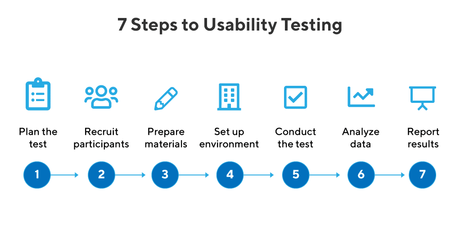It is an excellent idea to have other people judge your work and see if you are on the right path or not, especially when it comes to user experience.
In short, judging your work by yourself isn't always a good idea. You might think it isn't that good, while it may be, that is why we always live to learn and learn to live.
What is crucial for the success of your work is to learn from your users. This is the whole point of your work, right? For your users, and you have the potential to create the best outcome whenever your user experience is excellent. According to a study done, roughly about five users is all you need to find about 85% of the issues in an interface. Moreover, the probability of encountering errors during a test is about 31%. Where, when you add more than five users, the chance of learning decreases. So, instead of spending a huge budget on conducting usability testing with more than five participants, we recommend you stick to five people only.
Otherwise, usability testing has shown to be a great exercise when it comes to return on investment (ROI)because it helps understand the user's success rate and time needed in order to complete a specific task. Usability testing in software testing is important because it gives an accurate measurement of the tasks.
Well, let's not wait any further and see the seven steps you can use to conduct usability testing.
Read more: Testing Processes for Software Quality Analysis
What is Usability Testing?
Usability testing is a method of asking users to evaluate your product or website's user experience. The main goal of usability testing allows UX researchers to clearly initiate if their user experience is smooth enough for their website or product.
7 Steps to Conduct Usability Testing
 source: productplan 1. Plan
source: productplan 1. Plan Without a plan, you are only setting yourself up for failure. Planning is the most important part of the entire usability processing process. The way you start your planning will dictate how your whole process will go, so you want to set up the first step as perfectly as possible.
Here is what you can do to set up the perfect planning with a usability testing example:
- Find the area you want to focus on and the issues that arise with it. What kind of purpose does your testing have? How would your website benefit from usability testing?
- Try setting up a user persona to see the type of users you are conducting your usability testing for.
- What are you trying to find out? What kind of questions are you willing to set up?
To achieve your testing goals, you will want to try and find participants who are willing to rate it. Here are a few ways a custom software development company can consider to find participants:
- Find participants from your website by setting up a poll
- Use social media. It is an excellent way of reaching your audience and allows direct messaging.
- Reach out to your clients directly through email. People love it when you ask them what they think and usually want to help you out.
To be effective in gathering participants, you can try offering something in compensation for their efforts. It is a good way of showing appreciation and recruiting the people you need to conduct your usability testing. You can learn more about usability testing here.
3. Set up an Overview of your TestOnce you have planned out your test and done the research, it is time to create an overview. You want to find out how your test will look and what participants can expect from it.
What does this mean for you? It means that you will plan out all the scenarios your participants will be going through throughout the test. Let's take an example as you are trying to test a website that sells clothes.
You could say the following: "You are invited to a party that only allows you to wear the color black. Everybody at the party has to come dressed in black. You look everywhere in your house and find out that you never bought anything black. Well, now is the time to do so!"
After this scenario, this will encourage participants to search for a black product filter. By searching for this filter, it is testing your user's abilities to test filters on your website.
4. Gather Pre-testing DataBefore we set up the testing, we should consider collecting psychographic and demographic information by asking the following questions:
- When do your users shop online?
- How often do they shop online?
- What influences them to buy online?
- How do they try to find the products they want?
Also, you want to find out if your participants are getting stressed out or not when completing the tasks. In another scenario, you can have participants who will complete the tasks in a short period of time, and this is where you need to find out how and what they did.
5. Run the Testing SessionWhen the time has come to conduct usability testing, you can try communicating with each participant and leave room for feedback and customization. During the testing, you should be sure that your participant is comfortable within the testing phase, whether it is conducted in person or remotely. If remotely, you want to make sure they can hear you well.
In case you are recording the session, don't do it without the permission of your participants. Try being friendly throughout your testing phase and ask simple questions. During the first minutes, you want to get to know your participant and build some small connections. From this point on, you can continue to scale your testing phase, and if you are smooth enough, your participant won't even realize that you are getting more information from them.
6. What to not do During a SessionThis is a crucial step of the usability testing phase. You want to naturally guide your participants throughout the tasks of the testing phase and not de-motivate them. Here are some practical tips you can take into consideration:
- Be clear with your instructions and with the questions that you ask
- Try not to read the tasks from a list, it makes you look like you are trying to be too formal
- Pay attention to body language. You don't want to make your participant feel stressed out.
- Don't talk too much. You don't want to look like you are the center of attention and are controlling the conversation.
- Please don't make the user feel bad by disagreeing with them. Try to be neutral and respect all of their opinions.
- Don't interrupt your users. This is by far the rudest thing to do and will make you look bad. Even if you have to interrupt, be polite about it.
Finally, we are at the last step. Now, you have to analyze all of the data you have collected and come to a conclusion. Do this right after you have finished the other six steps.
Initially, try to analyze and figure out what were the issues your users may have encountered. Of course, something will go wrong, but it doesn't mean that you have to worry about every single issue. Instead, focus on those that are the most problematic and seek to resolve them.
Wrapping up Your 7 Steps
Well, we come to an end here. That's about it for this article. Hopefully, what seemed difficult for you to understand is not clear enough for you. Remember, usability testing should be a priority for providers of custom software development services, and that it is essential for knowing if you are on the right path or not.
This article seeks to improve user experience and shows you seven steps that are carefully researched. We recommend you pay attention to each step and even spend some time yourself exploring how it could help your testing method.
Use the resources you have, ask the right questions, analyze post results, and try to see how you can improve the issues that arise. If you pay close attention to each step we stated, everything will be easy for you to set up.

